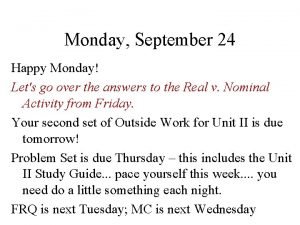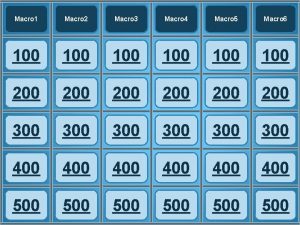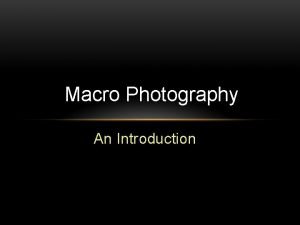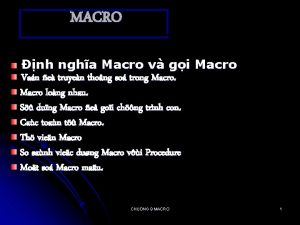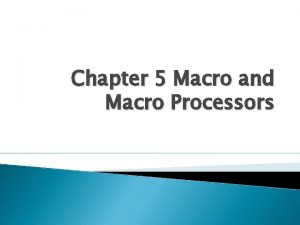TOPIC SCHOOL SIZE MACRO ANALYSES QUANTITATIVE ANALYSES SAMPLING












- Slides: 12

TOPIC: SCHOOL SIZE (MACRO ANALYSES) QUANTITATIVE ANALYSES & SAMPLING Jacob Werblow, Ph. D. Central Connecticut State University

Tonight’s Agenda Thesis workshop A simple structure to follow IV & DV review A beginner’s Template to Analyzing Research Sampling Practice analyzing a sample Summary of this weeks readings Practice & Prepare: framing your next paper

Thesis workshop Get into groups of 3 or 4 Swap your recent synthesis paper with another student Read their intro, and write thesis on the back of their paper. Pass the paper to another student who will write thesis on the front Return papers to author

Thesis workshop (cont) Reflection & discussion Are there varying differences between what you thought your thesis was and what others thought? How well do your body paragraphs directly support your thesis? Reading Strategies, what strategies do you use to skim the articles? Etc. .

A simple structure: NCLB Thesis: Support #1 Support #2 Support #3 Closure:

IV & DV Review DV = Dependent Variable (outcome) IV = Independent Variable (malleable, manipulated) After reading the Abstract, can you identify the IV and DV in the following two studies? Werblow & Duesbery (2009) Darling-Hammond, Ancess, & Ort (2002)

A beginner’s Template to Analyzing Research List: Author(s) Last Name, Initials (year). Title of the article. Name of Journal(Vol), p. # What is the main point of the article? Describe the methodology used (Include the number of subjects, controls, treatment, etc. ) Describe the findings. What, if anything, is notable about this article? (Is it a landmark (seminal) study? Does it have flaws? Is it qualitative or quantitative? Is it an experimental study? ) Note specific details you find especially relevant to the topic of your review (Make this as long as necessary). Taken from: Galvan, J. L. (2004). Writing Literature Reviews: A Guide for students of the Social and Behavior Sciences. CA: Pyrczak

Sampling: Basic questions to ask How were participants selected? How many were selected? Who was selected (demographics)? Did any participants dropout of the study? If so, how did the researcher account for this? What is the sample representative of? How generalizable is this sample?

Why sampling matters Many learning theories developed out of the field of psychology in the 1950’s, including Behaviorism, Cognitivism, and Socio. Cognitivism, among others. Almost all of which, were developed using a sample of middle-class, white children and adults. Are these theories appropriate to describe how children and adults learn in the U. S. today?

Analyzing the sample: Practice it Analyze the sampling of Darling-Hammond, Ancess, & Ort (2002)

A summary of this week’s reading http: //edresearch. yolasite. com/

Practice & Prepare Thesis: Support #1 Support #2 Support #3 Closure:
 Econmovies episode 5 worksheet answers
Econmovies episode 5 worksheet answers What is conditional macro expansion
What is conditional macro expansion What is the sample size in qualitative research?
What is the sample size in qualitative research? Sampling method in research
Sampling method in research Cluster sampling advantages and disadvantages
Cluster sampling advantages and disadvantages Stratified sample vs cluster sample
Stratified sample vs cluster sample Contoh target perilaku dalam observasi
Contoh target perilaku dalam observasi Cluster sampling vs stratified sampling
Cluster sampling vs stratified sampling Quota sampling definition and example
Quota sampling definition and example Natural sampling vs flat top sampling
Natural sampling vs flat top sampling Molecular ecological network analyses
Molecular ecological network analyses Importance of critical thinking in nursing process
Importance of critical thinking in nursing process Rhetorical analysis essay
Rhetorical analysis essay
